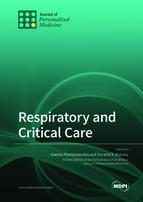Respiratory and Critical Care
A special issue of Journal of Personalized Medicine (ISSN 2075-4426). This special issue belongs to the section "Personalized Critical Care".
Deadline for manuscript submissions: closed (10 October 2022) | Viewed by 60032
Special Issue Editors
2. Assistant Professor, Department of Respiratory Medicine, Faculty of Medicine, University of Thessaly, Biopolis, 41500 Larissa, Greece
Interests: respiratory intensive care; acute critical care; emergency medicine
Special Issues, Collections and Topics in MDPI journals
2. Assistant Professor, Faculty of Nursing, University of Thessaly, Larissa, Greece
Interests: human pathophysiology; clinical and medical research; medical education
Special Issues, Collections and Topics in MDPI journals
Special Issue Information
Dear Colleagues,
The purpose of this Special Issue is to publish high-quality research papers as well as review articles to addressing recent advances on respiratory diseases and critical care. In particular, the topic of interest includes, but is not limited to, obstructive/restrictive/vascular/infectious respiratory diseases; sleep medicine; and related areas of experimental and clinical research in respiratory medicine, critical care, and nursing. Topics covered include:
- COPD
- Occupational disorders, and the role of allergens and pollutants
- Asthma
- Allergy
- Non-invasive ventilation
- Mechanical ventilation
- Therapeutic intervention
- Lung cancer
- Lung infections – COVID-19
- Therapeutic interventions
- Adult and pediatric medicine
- Cell biology
Original, high-quality contributions that are not yet published or that are not currently under the review by another journal are sought.
Dr. Ioannis Pantazopoulos
Dr. Ourania S. Kotsiou
Guest Editors
Manuscript Submission Information
Manuscripts should be submitted online at www.mdpi.com by registering and logging in to this website. Once you are registered, click here to go to the submission form. Manuscripts can be submitted until the deadline. All submissions that pass pre-check are peer-reviewed. Accepted papers will be published continuously in the journal (as soon as accepted) and will be listed together on the special issue website. Research articles, review articles as well as short communications are invited. For planned papers, a title and short abstract (about 100 words) can be sent to the Editorial Office for announcement on this website.
Submitted manuscripts should not have been published previously, nor be under consideration for publication elsewhere (except conference proceedings papers). All manuscripts are thoroughly refereed through a single-blind peer-review process. A guide for authors and other relevant information for submission of manuscripts is available on the Instructions for Authors page. Journal of Personalized Medicine is an international peer-reviewed open access monthly journal published by MDPI.
Please visit the Instructions for Authors page before submitting a manuscript. The Article Processing Charge (APC) for publication in this open access journal is 2600 CHF (Swiss Francs). Submitted papers should be well formatted and use good English. Authors may use MDPI's English editing service prior to publication or during author revisions.
Keywords
- Respiratory research
- Respiratory care management
- Respiratory intensive care
- Acute respiratory diseases
- Chronic respiratory diseases
- Respiratory nursing








